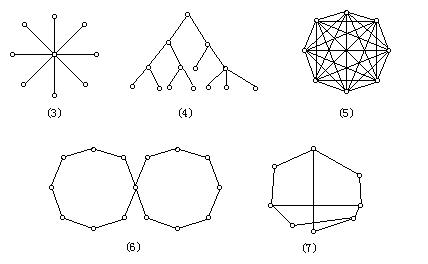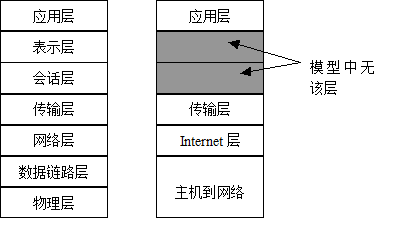Basic concepts of the internet #
Definition #
Computer Network refers to a general term for software and hardware systems that enable communication between computers. In a broad sense, copying data between two microcomputers using disks can also be considered a special type of network. Its more specific definition is “a system composed of multiple computers interconnected through data communication lines for the purpose of sharing resources,” including hardware devices, software, or data in computer networks.
Network topology and classification #
In computer networks, the connection method between network nodes, computers, or terminals is called the topology structure of the network, which affects the design, functionality, reliability, and communication costs of the network. Common topology structures include the following types: (Figure 13-1)
Star topology structure;
Bus topology structure;
Circular topology structure;
Tree topology;
Fully connected structure;
Intersecting rings;
Irregular topological structures, etc.

Fig. 197 Network Topology Structure (A.S. Tanenbaum) #
- among which:
(1)总线结构,(2)环形结构,(3)星形结构,(4)树形结构, (5)完全连接,(6)相交环形,(7)不规则拓扑结构
There are various types of computer networks with different performance, and they can be classified according to different principles. The most common classification is based on the size of their spatial distribution range, which includes LAN Local Area Network, MAN Metropolitan Area Network, and WAN Wide Area Network.
1) Local Area Network
It refers to a computer network established in a relatively small area, such as an office building, a campus, a company, etc., with short communication distance, fast transmission rate, and low bit error rate. For local area networks, the main topology structures used are bus structure and ring structure. The former, such as IEEE802.3, is commonly referred to as “Ethernet_TM” (Ethernet), while the latter, such as IEEE802.5, is IBM’s Token Ring.
2) Metropolitan area network
Basically, it is a large local area network with a similar topology structure that can cover a city and achieve information sharing.
3) Wide Area Network
The fundamental characteristic of a wide area network is its wide distribution range of machines, which enables large-scale information sharing. Generally speaking, the Internet belongs to the category of wide area networks. Wide area networks can adopt various topology structures, such as star, ring, tree, fully connected, intersecting ring, and even irregular topology structures.
The above network types are all connected by cables between nodes. In recent years, wireless networks have developed rapidly, and mobile computing can be achieved through wireless networks.
Internet #
The Internet refers to the world’s largest, open, and interconnected computer network composed of numerous networks. Its formation and development are undoubtedly the most exciting thing in the process of information technology development. Currently, colleges, universities, government departments, libraries, enterprises, and individuals have all been connected to the Internet, allowing network users to access any information on the network at any time and any place. It has brought great convenience to information dissemination and is changing the way of life of the entire human society. The predecessor of the Internet was ARPA (Advanced Research Project Agency) net, which was designed by the US Department of Defense in 1965. After careful planning, in 1969, computers distributed in four universities in the United States (UCLA, UCSB, SRI, UTAH) began exchanging data with each other, marking the birth of ARPAnet. Later, especially after the TCP/IP protocol was officially applied to ARPAnet in 1983, its access users grew rapidly. Due to the military background of ARPAnet, it caused inconvenience for more convenient access and connection. Therefore, NSF (National Science Foundation) established NSFnet, which has superior management and speed compared to ARPAnet. By 1990, many users switched from ARPAnet to NSFnet, and later NSFnet was interconnected with ARPAnet, resulting in exponential growth in its users. The integration of many regional networks (including Canada, Europe, Oceania, etc.) marks the ultimate formation of the Internet. Traditionally, the Internet has four main applications: Electronic Mail; News; Remote login; File transfer. Until the early 1980s, the Internet was limited to universities, governments, and so on, but the emergence of the World Wide Web (WWW) changed everything. WWW enabled a website to create pages that included text, images, sound, and even videos, written in HTML Hypertext Markup Language and embedded with links to other pages. WWW provides great convenience for users to query, retrieve, and browse various information published on the Internet, bringing a large number of non academic users to the Internet. In fact, the rapid development of the Internet is closely related to WWW applications, to the extent that when referring to the Internet today, it often specifically refers to WWW services. A more detailed explanation of WWW and related technologies will be provided later. Other internet applications include Gopher, WAIS, and so on. In computer networks, in order to enable correct transmission of information between connected computers or terminals, there must be a set of protocols regarding the sequence, format, and content of information transmission, known as computer network communication protocols. In network protocols, the Open System Interconnection Reference Model (OSI) was developed and established by the International Organization for Standardization (ISO) to establish standards for data communication protocols. Although the OSI model has not been truly applied in practice, its concepts and vocabulary are widely used and recognized in the computer networking community. The OSI reference model includes seven protocol layers to define the protocol functions of data communication, each layer is relatively independent and completes some functions in the data transmission process. At present, due to the development of the Internet, TCP/IP, as its basic protocol, is becoming increasingly widely used. TCP/IP specifically refers to two protocols, Transmission Control Protocol (TCP) and Internet Protocol (IP), in a narrow sense. In a broad sense, it refers to the TCP/IP reference model composed of multiple protocols related to the Internet, or the TCP/IP protocol stack. The TCP/IP model is similar to the OSI reference model, but is relatively simple and does not have a presentation layer or session layer. TCP and IP are two important protocols, with IP being a network layer protocol and TCP located at the transport layer. The TCP/IP application layer includes all high-level application protocols, such as virtual terminal (TELNET), file transfer (FTP, FileTransfer Protocol), email (SMTP, Simple Mail Transfer Protocol, and POP3 PostOffice Protocol), domain name service (DNS, Domain NameService), and Hypertext Transfer Protocol (HTTP, Hyper Text Transfer Protocol) used to transfer pages on the web. The OSI reference model structure and its corresponding relationship with the TCP/IP reference model are shown in Figure 13-2: Fig. 198 OSI Reference Model and TCP/IP Reference Model # In order to transmit information on the Internet, there must be a method to identify computers. The solution is to assign a unique 32-bit address, called an IP address, to each computer on the Internet. This 32-bit address is represented by a decimal number divided by dots, with each byte being a decimal value ranging from 0 to 255. In this way, the IP address is represented in the following form: 202.112.7.12 (Peking University WWW Server IP address). On the Internet, communication between computers is conducted through IP addresses. Due to the rapid development of the Internet, more and more computers are connected, and the existing 32-bit IP addresses are no longer sufficient to meet its further development needs. Therefore, the Internet Engineering Task Force (ITEF) has begun to develop an updated IP protocol standard called IPv6, according to which IP addresses will be identified using 16 bytes. Although communication between computers is achieved using their respective IP addresses, people are often reluctant to use hard-to-remember numerical strings and prefer more convenient textual names. Therefore, in addition to IP addresses, hosts on the network are usually assigned a name for identification. This name is called a domain name, which, like the IP address, is unique. The naming system used for this purpose on the Internet is called the Domain Name System (DNS). DNS is a hierarchical naming system that manages the names and addresses of all hosts connected to the Internet through a database. A domain name is a character string separated by dots, such as PKU.EDU.CN and OPENGIS.ORG. The rightmost segment is referred to as the top-level domain, which is divided into two categories: generic top-level domains and country-code top-level domains. The former includes .com (commercial), .edu (educational institutions), .gov (government agencies), .int (specific international organizations), .mil (military systems), .net (network providers), and .org (non-profit organizations), with generic top-level domains primarily used for sites in the United States. The latter uses two-letter codes to represent countries or regions, such as .cn (China), .ca (Canada), and .jp (Japan). As described earlier, the emergence of the World Wide Web (WWW) marked an epoch-making milestone for the Internet, enabling its applications to extend beyond specialized fields. The WWW, often referred to as the Web or 3W, is a collection of millions of interconnected documents stored on computers worldwide via the Internet, forming the largest electronic information repository in the world. In WWW applications, Web documents are hosted on one or more computers known as Web servers, and users access Web sites through browsers. The first version of the World Wide Web began operating in January 1992 in Geneva, Switzerland. Researchers could access web information from the CERN (European Particle Physics Laboratory) site. The widespread popularity of the Web should be credited to Mosaic, the first graphical web browser, which was designed and developed by the NCSA (National Center for Supercomputing Applications). Its user-friendly interface and ease of operation made it convenient for people to access web information. Currently, the most widely used browsers are Microsoft Internet Explorer and Netscape Navigator. On a website, documents are written using HTML, often referred to as HyperText. The term “hyper” signifies that the document contains hyperlinks (HyperLinks) to other documents, allowing users to jump to other documents by clicking on keywords. Since multimedia data such as music and images can be incorporated into hypertext, the concept of HyperMedia was introduced. HTML is a markup language independent of system platforms and applications. It uses special tags and reference characters to define the structure or formatting of web documents. Special HTML elements (such as the Anchor element) are used to define hyperlinks, and HTML form elements can be utilized to collect information from users. When users access a website, browsers and web servers exchange requests and information through the Hypertext Transfer Protocol (HTTP). When browsing the web, you will first encounter the concept of a URL (Uniform Resource Locator), which is the internet address of a web document. Its relationship to the document is similar to that of a table of contents and the main text in a book. The syntax of a URL is quite simple, consisting of two parts, formatted as: <scheme>:<scheme specific part> An HTTP URL is as follows: The host part consists of the server’s address (IP address or domain name), file path, and file name; The port part is the HTTP port number, which defaults to 80 and can usually be ignored; The search_part is often a request parameter sent by the browser to the server. Here is an example of an HTTP URL: In addition to the web, FTP, Gopher, and others also use URLs for resource localization. In the second half of the 1990s, with the development of the Internet, the new concept of Enterprise Internal Network (Intranet) emerged. In short, Intranet is the internal network of an enterprise, but this network also uses Internet based tools such as Email, web browsers, and file transfer, allowing an enterprise to fully enjoy various advantages of the Internet, such as information sharing and management, real-time communication and collaboration, and the use of distributed databases.History of Internet Development #
Application services provided by the Internet #
Network Protocol and TCP/IP #

Internet addresses and domain names #
WWW、HTML and URL #
Internal Internet of Enterprises #